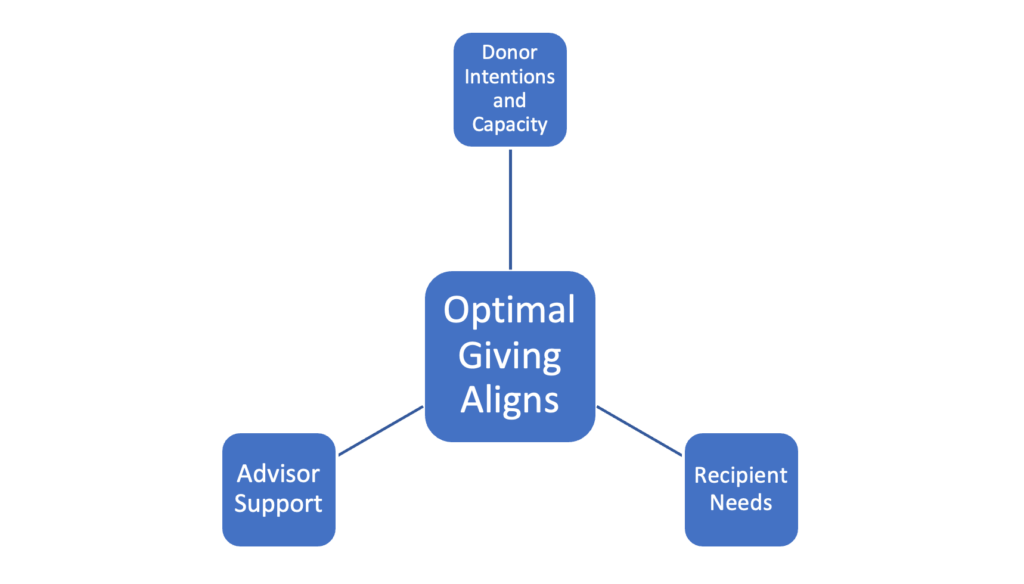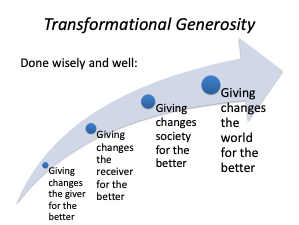As a nonprofit leader, you are dedicated to the mission of your organization and to making the world better because of your work. Resources are a key to your success, and fundraising is of central importance to the program outcomes you are seeking.

This blog is the first in a series exploring how to make the most of your development opportunities. We’ll explore the nature of giving itself and processes that can bring the most benefit to all the parties involved in a charitable or philanthropic gift.
Fundraising is essential to the life of a nonprofit, and ideal fundraising is strategic. Program needs inform what you ask for. Stakeholder considerations determine who you ask and how you ask them. Aligning these factors amplifies giving results. Your fundraising should not just be a one-way quest for money but a dynamic process that’s informed by your operations and desired outcomes while offering guidance about how to improve them.
WISEgenerosity produces “Optimal Giving.” It considers internal and external factors and seeks to align the motives and interests of everyone involved in the giving process.

Significant gifts involve three parties: the donor(s), the receiving organization, and the professional advisors working on behalf of the process. Too often, support fails to achieve its full potential in terms of size and impact because coordination and communication are lacking among these three groups. WISEgenerosity enables gift collaboration to succeed by harmonizing the interests and abilities of everyone involved.
W.I.S.E. Giving Leads to Optimal Outcomes.
Imagine two different giving scenarios. The situation in each is an initial meeting with a potentially significant contributor.
Scenario #1: Institution-Centered
In the first case, the nonprofit’s approach is transactional. The representatives walk into the conversation with a pre-determined request and amount in mind. The motivation is institution-centered. After all, the immediate needs are great, and the donor has the potential to meet them. After some pleasantries, an ask is made. The donor then has to decide whether or not to say yes and, if so, how much to provide.
The best outcome in this situation is a check for the requested amount. The donor is engaged superficially and likely is left unsatisfied. As a result, the potential for future support is limited. Furthermore, no advisor was needed or consulted.
Scenario #2: Donor-Centered
In the second case, the nonprofit focuses on the donor at the outset. Questions are asked. “How did you come to learn about our group?” “What interests you most in the work we do?” “What important personal goals do you hope we can help you accomplish through our efforts?” The motivation is donor-centered. The goal is discovering alignment between the individual’s interests and the institution’s needs. It is quite likely – even preferable – that no ask is made at all.
In this situation, the donor is engaged. The fundraiser is educated about the donor’s interests. Further conversations most likely will follow. The strategic nature of the discussion opens the door to consider gifts beyond a one-time contribution and assets beyond cash. No advisor is involved yet, but the stage is set for a much larger opportunity in need of professional support.
***
Which situation seems better to you? An honest answer may be uncomfortable.
If you are a development officer, your annual goals might be better served by getting a check right away. If you are a senior executive, you have a budget to meet. If you are a board member, you’d like to see a “win” happen right away while you are involved personally in the process. The proverbial “bird in the hand” might win out over the uncertain, deferred outcome of a more deliberate approach.
The key question to ask is, “Which method best serves the ultimate interests of both donor and nonprofit?” As we will explore in this series going forward, WISEgenerosity makes the second conversation much more likely to succeed.
W.I.S.E. giving is Well-grounded, Inspired, Satisfying, and Effective.
The “I” and “S” are donor-focused. Is the gift going to be meaningful for the giver while reflecting their values and interests? Will they feel rewarded by knowing that it was well planned and executed?
The “W” and the “E” are nonprofit-focused. Is the request thoughtful and productive? Will it then lead to the positive outcomes that were promised?
“Yes” answers to these questions are highly likely to produce much better results in the end for everyone involved.
W.I.S.E. Giving Is Transformational
In future posts, we are going to consider the elements introduced here. What are donor interests and motivations? How can nonprofits relate to them most productively? When and how does it make sense to engage professional advisors in the donation process?
For now, a final thought.
Transactional giving is incremental and limited. It is arithmetic – growing one gift at a time.
W.I.S.E. giving is transformational. It is exponential – inspiring the donor and offering the potential for greater impact to the organization and beyond.

WISEgenerosity cultivates transformational change for your donors, for your organization, for the area in which you work, and for the wider world. Generosity University aims to serve and support you and your organization with these ends in mind.
Let’s begin….
